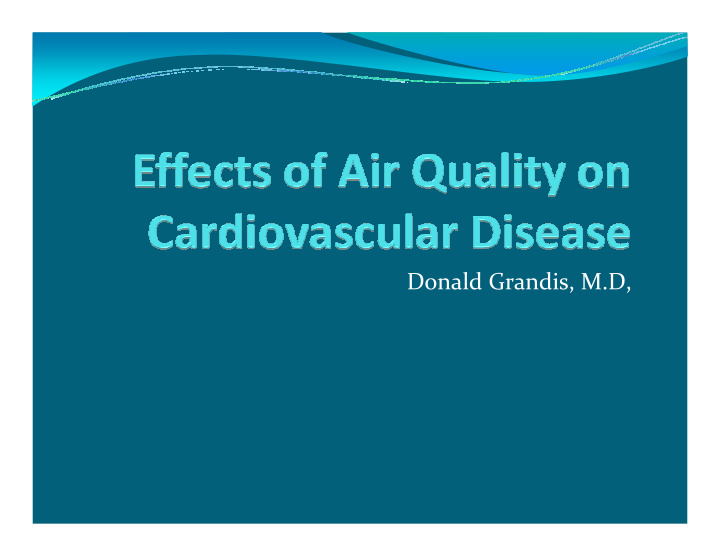



Donald Grandis, M.D,
A Real Life Case Presentation � M.F. is a 64 year old woman with no history of high blood pressure, diabetes mellitus, high cholesterol, or cigarette smoking. � She developed severe chest pain on the evening of 01/14/08 and presented to the Emergency Department the following morning. The diagnosis of an Acute Myocardial Infarction (heart attack) was made. � She underwent an emergency coronary angioplasty and has done well since.
Cardiovascular Disease Facts � Cardiovascular Disease remains the leading cause of death in the U.S. � Approx. 800,000 Myocardial Infarctions occur each year in the U.S. � Annual Cost is $76 billion. � Risk factors include age, smoking, high cholesterol, high blood pressure, diabetes mellitus, and male gender. � 50% of patients have “normal” cholesterol levels and 20% have no known major risk factors.
Air Pollution as Risk Factor for Cardiovascular Disease � Dublin, Ireland banned coal sales 1990, reduced black smoke 35.6 µ g/mm 3 and saw an associated 10.3% annual reduction in cardiovascular mortality. � Based on over 15 studies worldwide, an increase in PM 10 of 10 µ g/mm 3 increases cardiovascular mortality 1.4% � In the US, during 24 hours, for each increase of 10 µ g/mm 3 in PM 10 , cardiovascular mortality increases 0.2% � A study in Allegheny County in 2004 found that an increase in PM 10 of 10 µ g/mm 3 increased the chances of admission for heart failure by 3%.
Allegheny County, Pennsylvania 2007
Limitations � Relative to other conventional risk factors, the risk of poor air quality causing cardiovascular disease is relatively low for a given individual. � Studies are associations, not causation. � Other factors such as lower income , education level, and lifestyle may be more prevalent in those with higher air pollution exposure. These factors might confound the findings. � “Harvesting”
Possible Effects of Air Pollution on Human Physiology � PM 10 particles and smaller are small enough to cross from lungs into blood stream. � PM 10 particles raise blood pressure. � PM 2.5 particles raise blood levels of CRP. � Diesel Exhaust raises blood levels of IL-6. � PM 2.5 particles raise activation of the nervous system which can lead to heart rhythm abnormalities. � PM 2.5 particles raise blood levels of fibrinogen . � PM 2.5 particle exposure increases vascular resistance
Role of Inflammation on Risk of Cardiovascular Events
In January 2008, when M.F. suffered her heart attack, the EPA air quality monitors were listed as orange (50 – 100 µ g/mm 3 ).
Changes in Life Expectancy for the 1980s-1990s, Plotted against Reductions in PM2.5 Concentrations for 1980-2000 Pope C et al. N Engl J Med 2009;360:376-386
Conclusion � As levels of PM 10 and PM 2.5 increase, the risk of death or hospitalization from cardiovascular disease increases. � The relative risk of cardiovascular disease due to poor air quality is less than that of conventional risk factors for the nation overall. However , the levels of PM 2.5 that are seen in Allegheny County generate risks similar to those seen with conventional risk factors � Unlike conventional risk factors which affect some of the population, air pollution affects everyone.
Recommend
More recommend